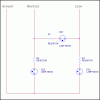Electroenthusiast
Active Member
Days back, electricity wiring (that came from a transformer and that) which connects to our building was cut under the road. There was some work that going on, the water supply board was carrying it. They dug the road, and cut-off the wiring of our building. Now, they have connected a temporary wire that takes an aerial route. They have interchanged phase and neutral. I found using this: LED's that describe the condition/state of wiring, in spike busters. [Attachment] That works pretty well, it is just arrangement of wires inside, with no any electronic chip.
I think we need to have some discussion on it's working.
Another ques - intention of this thread, My room's tube light keeps blinks continuously, even it is switched off. I can see this blink only in the dark(Night). I read this, which says:
So, i grasped that it was cause of interchanging the phase and neutral. How does it happen like that? Why does that happen?
I think we need to have some discussion on it's working.
Another ques - intention of this thread, My room's tube light keeps blinks continuously, even it is switched off. I can see this blink only in the dark(Night). I read this, which says:
PHP:
Blinking of tube lights is an indication of bad wiring in your house. The wiring has been reversed entirely in relative positions of live(phase) and neutral. You can test it using your small electric tester. Test the electricity in any 3 pin socket - you will observe that the either left of right (of yourself) will show the presence of electric current. If the current is present in right part of socket, the circuitry is proper, if you find the left portion shows the LIVE current, your home circuitry is wrong.



